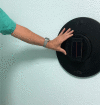Assessment of the perception of vertical subjectivity in children born preterm
- PMID: 36856887
- PMCID: PMC10175466
- DOI: 10.1007/s00431-023-04863-y
Assessment of the perception of vertical subjectivity in children born preterm
Abstract
Children born preterm have increased rates of paediatric mortality and morbidity. Prematurity has been associated with impaired visual perception and visuo-motor integration. The alteration of the perception of verticality translates into alterations of the vestibular system at central and/or peripheral level, which may manifest itself in symptoms such as imbalance, dizziness or even vertigo. The aim of this study was to compare subjective visual vertical (SVV) test scores in children born preterm with those of children born at term at ages between 7 and 10. One hundred ten children with no neurodevelopmental disorder of 7 to 10 years of age were studied using a mobile application on a smartphone attached to a wall by means of a rotating plate. The SVV test was compared between two groups: a group of 55 preterm children (53 very preterm children born under 32 weeks of gestational age and 2 preterm with very low birth weight) and another group of 55 children born at term (after 37 weeks of gestational age). The SVV results were analysed for comparison with respect to prematurity, sex and age. We found no significant differences in the SVV study in the comparison between preterm and term children. In addition, no significant differences were observed regarding sex or age between 7 and 10 years. Conclusion: We found no alterations in the perception of vertical subjectivity in children between 7 and 10 years of age, with antecedents of very preterm birth and/or very low birth weight. What is Known: • The different studies published so far suggest the existence of balance disorders in premature children, although in most of these studies the children are examined at an age when the vestibular system is not mature and with non-specific tests for the study of the vestibular system. What is New: • We compared the results of the subjective visual vertical (SVV) test in a group of 55 preterm children (53 very preterm children born under 32 weeks of gestational age and 2 preterm with very low weight at birth) and in a group of 55 children born at term (after 37 weeks of gestational age), at the ages of 7 to 10 years and observed no differences. • We conclude that, if there had been any vestibular alterations due to very premature birth, these must have been compensated by the age of 7.
Keywords: Balance; Prematurity; Smartphone; Vertical subjective visual test.
© 2023. The Author(s).
Conflict of interest statement
The authors declare no competing interests.
Figures
Similar articles
-
Subjective visual vertical and postural capability in children born prematurely.PLoS One. 2015 Mar 19;10(3):e0121616. doi: 10.1371/journal.pone.0121616. eCollection 2015. PLoS One. 2015. PMID: 25790327 Free PMC article.
-
Change in cognitive abilities over time during preschool age in low risk preterm children.Early Hum Dev. 2012 Jun;88(6):363-7. doi: 10.1016/j.earlhumdev.2011.09.011. Epub 2011 Nov 1. Early Hum Dev. 2012. PMID: 22051526
-
Peripheral vestibular loss detected in pediatric patients using a smartphone-based test of the subjective visual vertical.Int J Pediatr Otorhinolaryngol. 2015 Dec;79(12):2094-8. doi: 10.1016/j.ijporl.2015.09.020. Epub 2015 Sep 25. Int J Pediatr Otorhinolaryngol. 2015. PMID: 26434547
-
Cognitive, motor, behavioural and academic performances of children born preterm: a meta-analysis and systematic review involving 64 061 children.BJOG. 2018 Jan;125(1):16-25. doi: 10.1111/1471-0528.14832. Epub 2017 Oct 11. BJOG. 2018. PMID: 29024294
-
The effects of preterm birth on visual development.Clin Exp Optom. 2018 Jan;101(1):4-12. doi: 10.1111/cxo.12578. Epub 2017 Sep 3. Clin Exp Optom. 2018. PMID: 28868651 Review.
References
-
- Ream MA, Lehwald L (2017) Neurologic consequences of preterm birth. Curr Neurol and Neurosci Rep 18(8) - PubMed
-
- Xiong T, Gonzalez F, Mu DZ (2012) An overview of risk factors for poor neurodevelopmental outcome associated with prematurity. World J Pediatr - PubMed
-
- Hughes F (2007) Motor, cognitive, and behavioural disorders in children born very preterm. Dev Med Child Neur 97–103 - PubMed
MeSH terms
LinkOut - more resources
Full Text Sources




